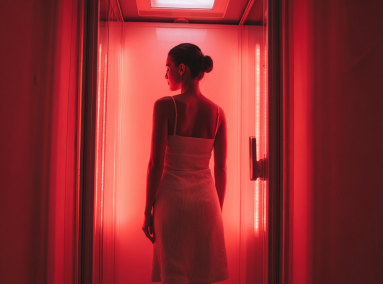
20 Years of Producing the Highest Quality, Most Reliable, and Effective LED mask.
Discover the power of red light therapy for daily recovery, muscle health, and skin rejuvenation. Learn how this evidence-based, home-use technology enhances wellness routines.

In the evolving landscape of personal health technology, few innovations have garnered as much scientific interest as red and near-infrared light therapy. What was once confined to clinics is now an accessible, evidence-informed option for daily recovery, muscle support, and skin care. At Led Mask, we've engineered a device that brings photobiomodulation into home wellness routines.
Red light therapy, or photobiomodulation (PBM), uses specific wavelengths to stimulate cellular processes that may promote healing and recovery. Research published in PMC notes that PBM “describes the use of red or near-infrared light to stimulate, heal, and regenerate damaged tissue,” with potential applications before and after exercise.
The proposed mechanism centers on cellular energy production. Studies suggest PBM increases cytochrome c-oxidase in skeletal muscle, which may support mitochondrial function and ATP synthesis. This cellular energy boost is thought to aid recovery, ease inflammation, and support tissue repair, though individual results vary.
Published trials continue to explore red light therapy for muscle recovery and skin appearance. Laboratory work indicates that photons may dissociate inhibitory nitric oxide from cellular enzymes, “leading to an increase in electron transport, mitochondrial membrane potential, and ATP production.”
For skin applications, controlled studies report improvements in patient-reported satisfaction and measurable changes in skin structure. A study in PMC examined “the safety and efficacy of two novel light sources for large-area, full-body, non-thermal PBM for improving skin feeling.”
Beyond surface effects, preliminary data suggest PBM may raise intracellular ATP and accelerate some cellular functions, providing a basis for further tissue-recovery research.
Our panel combines published research with practical design. Eighty-eight medical-grade LEDs deliver dual-spectrum output at 660 nm (red) and 850 nm (near-infrared), wavelengths frequently used in laboratory studies.
Key specifications:
Modern wellness routines benefit from tools that fit existing habits. Mount the panel beside the bed for evening sessions, keep it near a workout station for post-exercise use, or add it to daily skincare—each option adds minimal complexity.
Built-in features include:
Further reading:
Professional athletes and fitness enthusiasts may benefit from targeted photobiomodulation. The therapy supports natural recovery processes, helping ease muscle fatigue and stiffness while preparing the body for performance. A PMC study reported that photobiomodulation can aid muscle recovery and strength.
The 660 nm wavelength targets skin tissue and may support collagen production and cellular renewal. According to the Cleveland Clinic, red-light therapy is increasingly studied for skin-health applications. Short daily sessions can be added to most skincare routines.
The deeper-penetrating 850 nm near-infrared light reaches underlying tissues and may help relieve joint stiffness while supporting mobility. NIH-published research describes encouraging results for musculoskeletal applications.
Evidence-based wellness technology can be used at home without sacrificing quality. Our panels are built to the same output and safety standards found in clinics and spas, giving healthcare professionals, wellness practitioners, and individuals access to reliable photobiomodulation.
As research on photobiomodulation expands, integrating the technology into daily routines reflects a shift toward proactive, evidence-informed self-care. Convenient at-home red-light therapy, supported by a growing clinical evidence base, is becoming a common component of modern wellness plans.
With engineering focused on reproducible irradiance and peer-reviewed dosing parameters, users can add photobiomodulation to their routines knowing the devices are designed to meet published clinical benchmarks.
This information is educational and not a substitute for professional medical advice.
